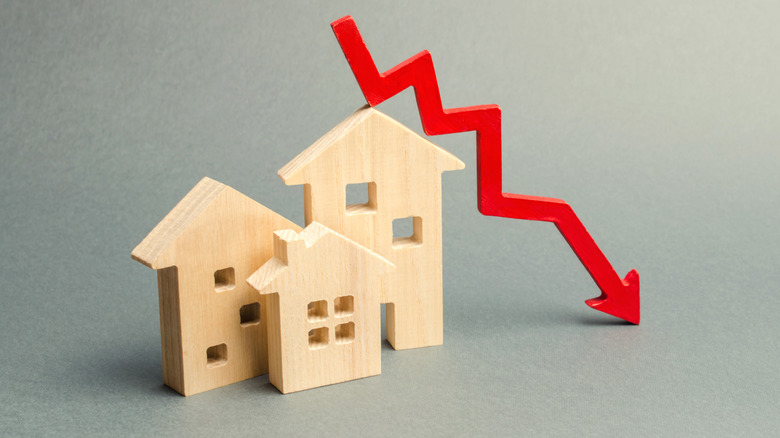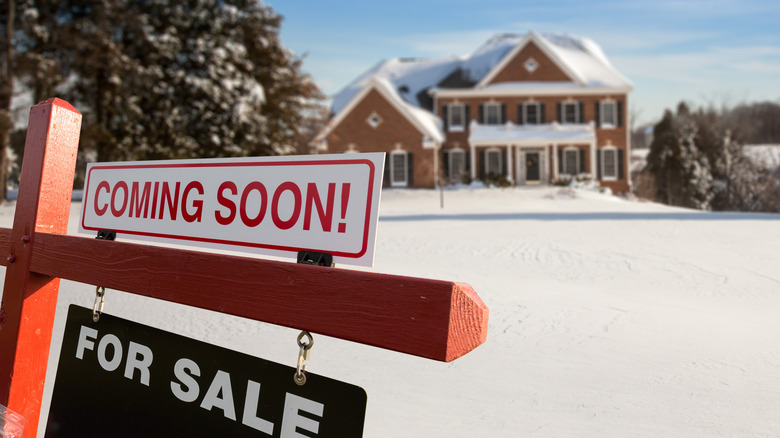Why Existing Home Sales Dropped Again In January
The last time you drove through your neighborhood, perhaps you noticed that the "for sale" sign at your neighbor's house had started to fade from the sun. If you listed your own house on the market a few months ago, you might even be wondering why your home hasn't gathered as much attention as you'd expected. It seems like just a year ago, houses barely touched the market before dozens of offers flew in. What's changed?
If you feel like the housing market drama has grown awfully quiet lately, you aren't imagining things. A recent report published by Realtor declared that we're in the midst of the longest-running market decline in over half a century. January 2023 marked the 12th consecutive month where turnover rates for existing single-family homes fell. Such a consistent drop in sales hasn't lasted this long since 1968. But what's the driving force behind this big housing market freeze? And what does it mean for prospective homebuyers? Here's what you need to know about the latest changes in the housing market — or the lack thereof.
The market has slowed to an iceberg pace
Existing home sales are down 36.9% since January 2021, a massive downhill swoop in just a few short years (via Realtor). Despite the rate of sales slowing to a crawl, home sale prices still aren't budging. Many homeowners don't want to sell their home for less than what it's worth, and right now, it's still worth a lot. In fact, the median home price rose 1.3% in January, with a typical home now costing around $359,000 (via Realtor). Of course, location plays a big role in home values and sales rates, with southern and western states still experiencing a massive influx of movers.
If you take the total number of available homes and divide that by the number of homes sold in one month, you can determine how quickly homes are moving. Ordinarily, before the pandemic, there was about a four to five-month "supply" of homes. In December 2020, the months-supply rate hit a record low of around 1.9, meaning that if no new houses were listed, all of the country's available homes would have been gone in 1.9 months (via the National Association of Realtors). According to Realtor, that number rose to 2.9 months this January, still a relatively fast market by pre-pandemic standards, but an obvious cooldown compared to December 2020. Even so, high mortgage rates and low supplies are still putting prospective buyers in a pinch.
How buyers are coping
There are plenty of empty houses out there, but there don't seem to be enough desirable and affordable homes on the market to accommodate all of the potential buyers. It's not that buyers are necessarily picky; most just want safe neighborhoods, good schools, and minimal structural issues — all of which are hard to find in today's frozen market. But if there's any benefit to real estate listings slowing down in 2023, it's that there's less pressure to sign right away or forfeit your spot. Real estate agent Trevor Gearin told Nerdwallet, "Six months ago, the buyers didn't have a chance to think. Now we're seeing buyers being able to negotiate a little."
According to Realtor, about 29% of homebuyers are opting for all-cash transactions, helping them to avoid hefty mortgage fees and beat out other buyers. But when about 63% of Americans live paycheck to paycheck, saving up for a cash offer isn't a feasible option for most people (via Zippia). If you're in the market to buy a house in 2023, now may be a good time to reassess your finances, savings, and budget. Consider all of your mortgage options and research to find the best plan that will work for you. The likelihood that housing prices will drop in 2023 is uncertain, but if they do, buyers who have planned and prepared ahead will have better odds of coming out on top.


